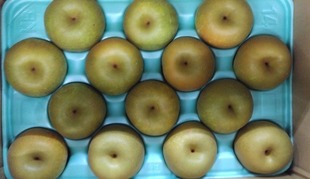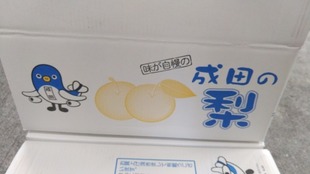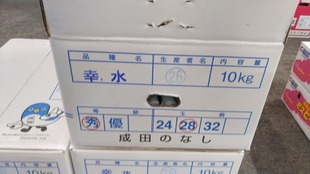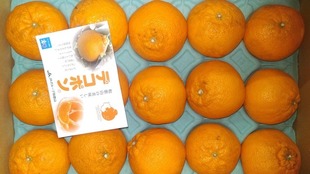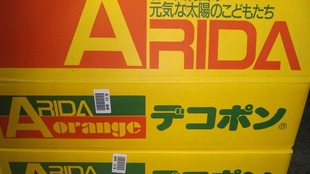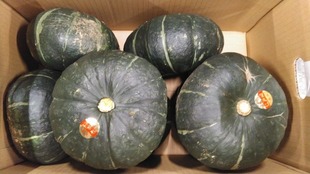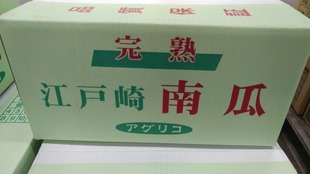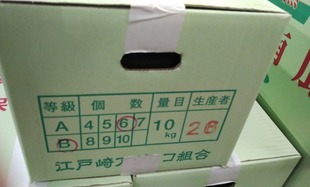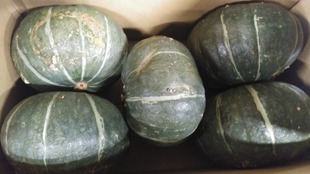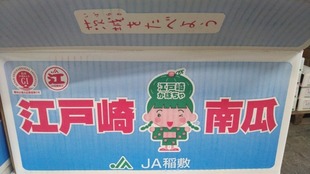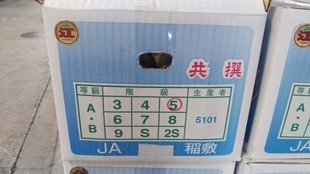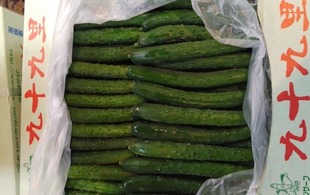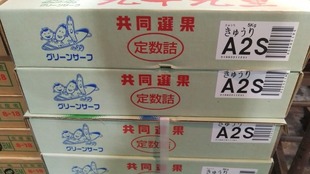Cucumis sativus L.
Oamishirasato City, Togane City, Kujukuri Town, Sanbu District, Sanbu City, Shibayama Town, Sanbu District, Yokoshibahikari Town (excluding former Hikari Town) (JA Sanbu District, JA Group Chiba)
"Hu" of cucumber is another name for different ethnic groups in ancient China. It has been cultivated since the Heian period via China.「木瓜(きうり)」「黄瓜(きうり)」熟すと, 黄色くなる事から.
Gurunavi, Inc. (Yuraku Town, Chiyoda Ward, Tokyo) and JA Sambugunshi cooperate in a smart business. After clarifying the work of agricultural workers, which had been managed entirely on paper until then, the material called "Cultivation Record Management Book" used by JA was created and submitted by farmers for each shipping type and field. Therefore, the amount of paper became enormous, and it seems that the check and management work load at JA was very heavy. By digitizing it, JA's work man-hours can be greatly reduced, work can be done with the minimum number of staff, checks can be simplified, and mistakes are disappearing. In many cases, farmers know how much they can sell for the first time after shipping, so income is not stable, and there seems to be instability such as a drop in prices, especially during a good harvest. In the demonstration, it seems that JA and farmers aim to visualize the shipping schedule by precisely sharing the work, growth status, and shipping status on the system, and to facilitate sales strategy and sales negotiations with actual demand. In addition, by returning and analyzing purchase data from the actual demand side from online supermarkets and restaurants, we have a market-in production and sales that captures consumer needs, and a sales system that takes into account the cultivation conditions of the production areas. By constructing, we aim to stabilize and increase the income of producers. “Oamishirasato City, Chiba Prefecture”, The city is located almost in the center of the Kujukuri Plain. It has a climate with abundant nature, with lush hills in the west, vast countryside in the center, and the coast of “Hakusasaisho(White sand, Pinus thunbergii Parl: One of the top 100 beautiful stretches of sandy beaches dotted with pine trees.)” in the east.It has an area of 58.08 km2 and is 9.8 m above sea level. In 1979, Concluded a sister town with the mountain town "Nakanojo Town". Agatsuma District, Gunma Prefecture is a town of Scenic Beauty by beautiful mountains and abundant hot springs. In a natural environment different from Oamishirasato City, which faces the Pacific Ocean and has the sea. On October 10, 2006, the "Agreement on Mutual Support in the time of disaster" was also signed. Let's continue to investigate history. Plateaus and hills that connect to the Toke district of Chiba City spread to the west, and sand dunes that have been deposited since the early Jomon period spread to the east. Research has been carried out since the 1945's, and among them, Kutsukake shell mound, Kamikaizuka, and Minamiiizuka ruins have been known for a long time. The Shimosa Plateau, which has an altitude of 80 to 90 m, extends over the western plateau. Prior to the construction of residential areas and golf courses, the oamiyamadadai archaeological site, sunada archaeological site, mizuhooketsu archaeological site, Kanayago archaeological site, etc. Many People are said to have started living in the Paleolithic era, 20,000 to 30,000 years ago. It is said that the earth at that time was a cold period called the ice age, the sea level was more than 100 m lower than the present, and the continent and the Japanese archipelago were connected by land.Tomita Village: Fujufuse (Not Receive and Not Give) School of the Nichiren Sect is a sect whose founder was Nichiren and the school founder was Nichio. As a special product, the strawberry "shinku-no-misuzu" born in Oamishirasato is known. Developed by a strawberry breeder living in the city, it was registered as a variety in 2015. Even the flesh is dyed deep red and has a high sugar acid ratio. The catch phrase is "All, love." The color, aroma, taste, and sweetness are all rich. Wordplay that puts that "dark" into “love”. 県指定遺跡 : 宮谷県庁跡-1868, 安房上総知県事: 芝山典 氏, 大網, 本國寺, 明治時代, 昭和29年12月21日, 絵馬著色武者絵- 牛若丸, 弁慶, 京の五条橋: 土気城主, 酒井伯耆守康治 公, 1579: 土気飛地, 縣神社, 安土桃山時代, 昭和37年5月1日, 木造日蓮聖人坐像-五穀豊穣, 農民の報恩碑(2基): 大網, 本國寺, 室町時代, 平成16年3月30日, 市指定文化財 :史跡-南玉不動尊の滝: 南玉, 不動尊清岸寺, 平安時代, 昭和47年5月1日, 建造物-宮谷八幡宮本殿: 大網, 宮谷八幡宮, 室町時代, 昭和47年5月1日, 正法寺の講堂 / 中門及び額: 小西, 正法寺, 室町時代, 昭和47年5月1日. “Togane City”, With a population of about 60,000 and a warm climate.It is located in the central part of the prefecture, about 50 km from central Tokyo. In the plains, good countryside extends toward the Pacific Ocean, and the hills are covered with Sanbu cedar forest(Chiba Prefecture A variety of cutting sugi that has been cultivated in the Sanbu area in the northeast for over 250 years(A variety selected from particularly excellent ones and cultivated by cuttings. Cryptomeria japonica; カンノウスギ). In the Edo period, the "Onari Kaido" was built for falconry of Ieyasu Tokugawa. A post town and a wholesale district where neighboring agricultural products gather are formed. Since then, it has become a popular distribution center for logistics and has developed as a core city in the Kujukuri area. The area is 89.12 km2 and the altitude is 8.1 m. The excavation survey of the “Maruyama site” was around 1957. This is because the landowner Eiichi Ichihara at that time discovered a large amount of earthenware and burnt soil while cultivating the fields. The excavation survey was conducted in early January 1960 under the guidance of Akira Kawato, who was a teacher at Togane High School at that time. The remains are confirmed on the upper surface of the Kanto loam layer, which is dug down about 20 cm to 30 cm from the ground surface (field at that time). Many relics were excavated in the process of removing the soil accumulated on the remains, and it was found that the remains were four dwellings. After that, along with the large-scale development in the 1950s, the area around this site was excavated as the Toganedai site group. 155 pit dwellings were detected at the Ebigaya site, 142 at the Toganekuroda site, 265 at the Shikidai site, and 109 at the Koyuidai site. In the re-survey of the Maruyama site conducted at this time, about 105 pit dwellings were confirmed. It was a valuable survey to learn about the lives of people from the Kofun period to the Nara and Heian periods. Besides, Hachigaya site, etc. 国指定記念物(天然記念物): 成東 / 東金食虫植物群落, 山武市島字畑田 / 東金市上武射田字入道島, 他, 国(山武市), 大正9年7月17日, 県指定有形文化財(建造物): 八坂神社本殿内殿1棟, 東金市松之郷, 八坂神社, 平成15年3月28日, 県指定有形文化財(絵画): 絹本著色天台大師像1幅, 東金市東金, 最福寺, 平成22年3月19日, 県指定有形文化財(考古資料): 鉢ヶ谷遺跡第1号縄文土壙出土遺物一括, 東金市東岩崎, 東金市, 平成14年3月29日, 県指定無形民俗文化財 : 東金ばやし, 東金市岩崎 / 押堀(日吉神社), 東金ばやし保存会い若会 / 雷囃子保存会, 昭和38年5月4日, 県指定無形民俗文化財 : 北之幸谷の獅子舞, 東金市北之幸谷(稲荷神社), 北之幸谷獅子連, 昭和39年4月28日, 国登録有形文化財(建造物): 多田屋本社社屋他2件, 東金市東金, 個人, 平成11年10月14日, 国登録有形文化財(建造物): 八鶴亭本館他5件, 東金市東金, 他, 株式会社八鶴亭 : 平成21年4月28日. “Kujukuri Town, Sambu District”, A monument of "the birthplace of Sweet Potato cultivation in the Kanto region" is erected here. The eighth shogun, Yoshimune Tokugawa, ordered Konyo AOKI to grow sweet potatoes and made a prototype at the current Kujukuri Town Fudodo. As a result, sweet potato cultivation has become widespread in the Kanto region and remote islands since the Kyoho famine. As a result, it is commented that, since the Great Famine of Kyoho Grape, the cultivation of sweet potato spread in Kanto region and solitary islands, and thus a lot of people's lives were saved in the Tenmei Famine :(The 8th general of the Edo bakufu (Japanese feudal government headed by a shogun) Yoshimune TOKUGAWA had already ordered Konyo to cultivate the known sweet potato as an emergency crop at the famine in West Japan, and make trial pieces in the Koishikawa Medicine Garden (Koishikawa Botanical Gardens), Makuwari village in Chiba District of Shimousa Province (present Makuhari, Hanamigawa Ward, Chiba City, Chiba Prefecture), and Fudodo Village in Yamabe County of Kazusa Province (present Kujukuri Town, Sanbu District, Chiba Prefecture). Kujukurihama was chosen as the marathon site because Tadataka INOU, a geographical surveyor in the Edo period, was born in Kujukuri Town. Kujukuri beach: Located almost in the center, "katakai" has prospered with sardine fishing since the Edo period, and is a town where "sardine culture" lives. “Cucumber”, Main cultivars in the area; ハイグリーン21-株式会社 埼玉原種育成会(Shobu Town, Kuki City, Saitama Prefecture): Operating System(OS; 企業独自; Company Own)Mating. Overwintering, forcing, semi forcing species. Very delicious for winter and spring cucumbers. The skin is thin, the flesh is thick, it has a crispy texture, and it has sweetness and flavor. Strong against light and hard to get sunburn. The color does not fade even at high temperatures. Also, it has a relatively strong impression of drying. Excellent vitality and yield are stable and high paced, and high yield. And the excellent product rate is also outstandingly high. I heard that it is an excellent species recommended for full-time farmers and winter spring production areas. 県指定無形民俗文化財 : 九十九里大漁節, 山武郡九十九里町, 片貝九十九里大漁節保存会, 昭和38年5月4日, 県指定無形民俗文化財 : 西ノ下の獅子舞, 山武郡九十九里町西ノ下, (八坂神社), 西ノ下獅子舞保存会, 昭和45年1月30日, 県指定記念物(史跡): 伊能忠敬出生地, 山武郡九十九里町小関, 個人,(九十九里町), 昭和44年1月10日, 県指定記念物(史跡): 青木昆陽不動堂甘藷試作地, 山武郡九十九里町不動堂, 九十九里町, 昭和44年4月18日. “Sanmu City”, Located in the eastern part of Chiba prefecture. It faces the Pacific Ocean for about 8 km in the center of Kujukuri beach, one of Japan's leading sand coasts, and has a total area of 146.77 km2. It is roughly divided into the Kujukuri coastal area, the vast alluvial plain as a hinterland, and the hilly area consisting of low plateaus at an altitude of 40 to 50 m. These are strips that are almost parallel to the coastline, and for some reason they are nostalgic scenery. The city is active not only in rice cultivation but also in vegetable and fruit production. In areas rich in nature, with forest products such as Sanbu Cedar, seafood from Kujukuri Beach. As a tourist resort, you can enjoy sports such as swimming, surfing, and tennis, and it has local resources that are attractive to young people. Due to the good location, the concentration of industrial facilities is increasing, and because of the good nature environment, many people visit and move to this area. The area was recognized as a blank area in the early Kofun period, but the Shimato Sakai No. 1 burial mound (4 mirrors) was discovered in the latter half of the early Kofun period (late 4th century). The case is Kitano No. 5 Mound, the second case designated on September 13, 2011. In the category of bronze ware, there were bronze swords, bronze pikes, bronze dagger-axes, bronze bells, bronze mirrors, and so on. Although it was made in various periods, as a historical and archaeological term, it often refers to the bronze mirror excavated from the remains in China, Korea and Japan. In 2006, Sambu District Naruto Town, Sambu Town, Matsuo Town, and Hasunuma Village merged. Naruto and Togane carnivorous plant communities are nationally designated natural monuments. The birthplace of the poet Ito sachio, known for his novel "The Tomb of Wild Chrysanthemum," is a historic site designated by the prefecture. 国指定 : 成東 / 東金食虫植物群落, 山武市島, 東金市上武射田, 1920年7月17日, 登有, 九十九里教会, 松尾町松尾, 1999年8月23日, 県指定史跡 : 歌人伊藤左千夫の生家(山武市歴史民俗資料館), 殿台, 1950年11月3日, 記天, 成東町のクマガイソウ, 成東, 1952年11月3日, 有建, 五所神社本殿, 蓮沼イ, 1954年3月31日, 民有, 八幡神社のいざりばた, 白幡, 1967年3月7日, 史跡, 稲葉黙齋の墓, 成東, 1974年3月19日, 記天, 石塚の森, 成東, 1975年3月28日, 有彫, 木造四天王立像 / 木造阿難 / 迦葉立像, 松ケ谷, 1979年3月2日, 有彫, 銅像阿弥陀如来及び両脇侍立像, 歴史民俗資料館, 1980年2月22日, 有彫, 木造釈迦如来坐像, 川崎, 1980年2月22日, 史跡, 大堤権現塚古墳, 松尾町大堤, 1990年3月16日, 史跡, 山室姫塚古墳, 松尾町山室, 1992年2月28日, 有考, 島戸境1号墳出土遺物, 麻生新田, 1995年3月14日. 市指定 : 有歴, 歌人伊藤左千夫の遺品 / 書跡 / 書簡 / 図書(山武市歴史民俗資料館), 歴史民俗資料館, 1973年7月19日, 史跡, 不動塚古墳, 板附, 1973年7月19日, 記天, 長光寺のしだれ桜, 埴谷, 1975年6月1日, 記天, 賀茂神社の大杉, 森, 1975年6月1日, 有歴, アララギ書画, 埴谷, 1975年6月1日, 史跡, 妙宣寺の史跡, 埴谷, 1976年3月22日, 史跡常福寺の旧跡, 埴谷, 1976年3月22日, 有建, 御嶽神社とその周辺, 植草, 1976年3月22日, 有建, 元倡寺九重の塔, 成東, 1976年7月30日, 有建, 不動院長勝寺本堂(浪切不動院), 成東, 1976年7月30日, 有考, 弥生式土器, 山武市殿台, 1976年7月30日, 史跡, 安井理民出生地 / 墓, 成東, 1977年3月25日.民無, 本須賀北京塚の獅子舞, 本須賀, 1977年12月1日, 史跡, 牧野萬右衛門出生地 / 落花生栽培発祥地, 草深, 1977年12月1日, 記天, 柴原地区岩塊, 柴原, 1979年1月29日, 有彫, 箭挿神社扁額 / 源頼朝坐像, 山武市蓮沼ハ, 1980年7月1日, 有建, 観音寺斎念佛塔, 松尾町山室, 1980年7月24日.有建, 浅間神社庚申塔(庚申塔), 松尾町田越, 1980年10月30日, 有考, 古和こくぞう山板碑(板碑), 松尾町古和, 1980年12月11日, 史跡, 百人塚(元禄大津波供養塚), 本須賀, 1980年12月22日, 史跡千人塚(元禄大津波供養塚), 松ケ谷, 1980年12月22日, 有建, 早船庚申塔と地蔵尊(庚申塔), 早船, 1980年12月22日, 有歴, 蓮沼学校扁額, 歴史民俗資料館, 1981年8月1日, 有書, 稲葉黙齋「姫島講義真蹟書」, 根蔵, 1982年6月24日. 民無, 白幡八幡神社神事 (1) お竹取りの行事, (2) お龍頭の舞, (3) 曙の祭典/ あげ飯の行事, 山武市白幡, (1) 1982年6月24日, (2) 1982年6月24日, (3) 2002年3月25日, 記史, 矢原墓地, 成東, 1982年6月24日, 有考, 海獣葡萄鏡, 湯坂, 1982年9月11日, 有書稲葉迂齋書跡 / 稲葉黙齋書跡, 湯坂, 1982年9月11日, 有考, 小川妙見板碑(板碑), 松尾町小川, 1983年1月28日有考上大蔵板碑(板碑), 山武市松尾町上大蔵, 1983年1月28日, 有書, 稲葉迂齋書跡 / 稲葉黙齋書跡, 姫島, 1983年5月24日. 有建, 六所神社本殿, 木原, 1983年6月1日, 有絵, 谷文晁の絵画, 姫島, 1985年3月23日, 史跡, 鈴木荘内(養察)の墓山武市姫島, 1985年3月23日, 史跡, 和田守道(儀丹)の墓, 成東, 1985年3月23日, 有建室の木宝篋印塔(宝篋印塔), 成東, 1985年7月29日, 有建, 室の木庚申塔(庚申塔), 成東, 1985年7月29日, 有建, 石仏, 真行寺, 1985年7月29日, 有建, 八坂神社石燈籠(石燈籠), 上横地. 1985年7月29日, 有建, 道路元標, 富口, 1985年7月29日, 有建六観音(六観音と六地蔵), 富口, 1985年7月29日, 有建, 結界石, 山武市松ケ谷, 1985年7月29日, 有建, 正福寺庚申塔(庚申塔), 松ケ谷, 1985年7月29日. 有歴, 勝覚寺芭蕉句碑, 松ケ谷, 1985年7月29日, 有建疱瘡神, 山武市木戸, 1985年7月29日, 有建, 大正寺宝篋印塔(宝篋印塔), 山武市本須賀, 1985年7月29日, 有建, 大正寺宝篋印塔(宝篋印塔), 本須賀, 1985年7月29日, 有建, 白幡八幡神社石燈籠(石燈籠), 白幡, 1985年7月29日, 有歴, 明治元年の「五榜の高札」(高札), 歴史民俗資料館, 1985年12月27日, 民無, 五所神社十二面神楽, 蓮沼イ, 1986年4月1日, 有彫, 金剛勝寺の彫刻(銅像三尊造および木造愛染明王像), 戸田, 1986年5月9日, 記天, 駒形神社の椎の木, 富田, 1986年6月16日, 史跡, 伊藤家の墓(山武市歴史民俗資料館), 殿台, 1986年10月15日, 有歴, 青い目の人形(日米「友情の人形」), 成東, 1987年3月5日, 有建, 六観音 / 六地蔵(六観音と六地蔵), 松尾町借毛本郷, 1990年1月31日, 史跡, 上総道学発祥の地, 成東字下町, 津辺字新町, 1990年6月20日, 史跡, 大高善兵衛の墓, 富田, 1992年1月24日, 有歴, 明和七年の「高札」(高札), 歴史民俗資料館, 1993年3月22日.民無, 末広神社の神楽, 松尾町松尾, 1996年4月15日, 民無, 金刀比羅神社の神楽, 松尾町八田, 1996年4月15日, 民無, 稲荷神社の神楽, 松尾町本柏, 1996年4月15日, 民無, 大宮神社の神楽, 松尾町折戸, 1996年4月15日, 有建, 出羽神社本殿の彫刻, 松尾町五反田, 1996年4月15日, 有歴, 谷津村相給野論絵図, 松尾町谷津, 1996年4月15日, 有建, 光福寺庚申塔(庚申塔), 寺崎, 1997年11月21日, 有建, 五所神社石灯籠(石燈籠), 蓮沼イ, 1998年10月29日, 有建, 稲荷神社大鳥居, 蓮沼ニ, 1998年10月29日, 有歴, 白幡八幡神社句学(句額), 白幡, 2002年3月25日, 有歴, 芝原安房神社句額(句額), 柴原, 2002年3月25日.有工, 妙見菩薩懸仏, 成東, 2002年3月25日, 有書, 亀足集, 富田, 2002年3月25日, 有歴, 明和七年の「高札」(高札), 津辺, 2002年3月25日, 有歴, 福星寺の「興讓館」扁額, 成東, 2002年3月25日, 有古, 里見義康印判状, 富田, 2002年3月25日, 有古, 成東領和田村御縄打水帳(検地帳), 和田, 2002年3月25日, 有古, 真行寺村 / 下大蔵村野論裁許状, 歴史民俗資料館, 2002年3月25日, 有古島村 / 殿台村野論「定」, 島, 2002年3月25日, 有古, 柴原村 / 早船村用水「定」, 柴原, 2002年3月25日, 有古, 成東村ほか, 結城藩領村絵図, 山武市和田, 2002年3月25日, 史跡, 覚眼法印の墓, 松ケ谷, 2002年3月25日, 有彫, 聖観音菩薩立像(舎利光観音), 蓮沼ハ, 2004年9月30日, 有建, 若宮八幡神社本殿, 雨坪, 2006年1月26日, 有彫, 妙宣寺の仏像, 埴谷, 2009年9月17日, 有考, 重圏文鏡, 山武市, 2012年9月13日, 有彫, 長光寺の日禅上人坐像, 山武市埴谷, 2011年9月13日, 史跡, 旭ノ岡古墳(蕪木1号墳), 松尾町蕪木, 2014年3月26日, 有考, 真行寺廃寺跡出土墨書土器, 山武市, 2014年12月2日, 有絵光明寺の仏画, 富田, 2017年9月21日. “Shibayama Town”, Located almost in the center of the Hokuso plateau in the northeastern part of the prefecture. At the northernmost point of Sambu District, in the 60km area of the capital. Adjacent to Tako Town in the east, Yokoshibahikari Town and Sammu City in the south, Tomisato City in the southwest, Narita City in the north, and Narita Airport. 8.4 km east-west, 10.5 km north-south, 43.24 km2 in area, generally flat. The Takaya River flows to the east and the Kido River flows to the west, and this basin becomes a rice-growing area, and upland fields are flourishing in the hills in the northwest. Many wild Cerasus jamasakura (Sieb. ex Koidz.) H.Ohba (1992) bloom in the hills of the town, and are most familiar to the townspeople. With its ancient history, culture, and beautiful nature, it is eager to become the courtyard of the international airport city. Various house-shaped haniwa of the mid Kofun period (tumulus period) were excavated from Tonobeta number 1 mound in Shibayama Town, Sanbu County, Chiba Prefecture and Nagase Takahama site in Umanoyama burial mounds located in Hawai Town, Tohaku District, Tottori Prefecture. Kannokyoji Temple: The three-storied pagoda in the precincts is designated as a tangible cultural property of Chiba Prefecture. Koike Otsuka Tomb, Takada No. 2 Mound, Yamada / Houma tumulus group. Arai Festival (Radish Festival): It is a festival held on December 14th every year, and it is said that fire should not be used except at the house on duty. At the house on duty, Shishi-Mai(Lion dance)will hold a festival of disease-free breathing, fire theft, and a good harvest. At Omiya Shrine, a turret built in front of the shrine is set on fire. The practice of throwing radishes at the child and preventing the priest from entering the shrine from the front is a sight to see. Prefectural designated cultural property : 有形建造物, 観音教寺三重塔, 芝山, 観音教寺, 昭和30年12月15日, 昭和31年7月13日1基, 無形民俗, 白桝粉屋おどり, 大里白桝地区, 白桝粉屋おどり保存会, 昭和43年4月9日, 文化協会芸能発表会, はにわ祭, 有形考古資料 : 芝山古墳群(殿塚・姫塚)出土埴輪, 芝山, 観音教寺(町立博物館寄託), 昭和46年3月26日9点, 町立芝山古墳 / はにわ博物館, 有形建造物 : 旧藪家住宅, 芝山, 芝山町, 昭和49年3月19日1棟, 芝山公園, 有形考古資料 : 庄作遺跡出土の墨書土器資料群, 芝山, 芝山町, 平成22年3月19日一括, 町立芝山古墳 / はにわ博物館, 町指定文化財 : 有形彫刻, 仁王尊像, 芝山, 観音教寺, 昭和51年4月20日2躯, 有形彫刻 : 阿弥陀如来坐像, 新井田, 称名寺, 昭和51年4月20日1躯, 有形建造物 : 朗海上人の板碑, 芝山, 観音教寺, 昭和51年4月20日1基, 有形考古資料 : 双口土器, 芝山, 芝山町, 昭和51年4月20日1個, 町立芝山古墳 / はにわ博物館, 有形考古資料 : 鮭のはにわ, 芝山, 観音教寺(町立博物館寄託), 昭和51年4月20日1個, 町立芝山古墳 / はにわ博物館, 天然記念 : 物普賢院の槙の木, 大里, 普腎院, 昭和51年4月20日1樹, 有形工芸品 : 芝山象嵌の扁額, 芝山, 芝山町, 昭和53年10月2日1面, 町立芝山古墳 / はにわ博物館, 史跡 : 国会開設の先覚者桜井静の墓碑, 小池字丸千代, 個人, 昭和55年2月15日1基, 有形彫刻 : 徳蔵寺本尊坐像, 飯櫃, 徳蔵寺, 昭和55年12月20日1躯, 天然記念物 : 熊野神社の椰の木殿部, 田字門前, 熊野神社, 昭和55年12月20日1樹, 天然記念物 : 上吹入の杉と椎の双体樹, 上吹入字稽古, 個人, 昭和55年12月20日2樹, 無形民俗 : 神楽獅子(殿部田のお囃子), 殿部田区殿部田お囃子保存会, 平成3年6月3日, 天然記念物 : 相馬高神社本殿脇の大杉, 上吹入, 相馬高神社氏子, 平成9年2月5日1樹, 有形彫刻 : 聖観世音菩薩立像, 大里, 承天寺, 平成26年9月12日1躯.国登録文化財 : 建造物, 伊東家住宅主屋, 小池, 個人, 令和2年8月17日1棟. “Yokoshibahikari Town”, Located in the northeastern part of the prefecture. Kujukuri Beach, with its white sands in the south, and gentle hills in the north. The average annual temperature is 15 degrees Celsius, with cool summers and warm winters, with a pleasant climate. On March 27, 2006, sanbu district yokoshiba town and Sousa District hikari town merged. The scenery of Kujukuri Beach, where the Pacific Ocean spreads magnificently, and the Kuriyama River, which flows through the central part of Yokoshibahikari Town, shines. It is a long and narrow terrain from north to south, and as it progresses from the flat coast to the plateau, it becomes slightly inland and the temperature difference. In general, it is blessed with natural conditions suitable for agriculture, which is cool in summer and warm in winter. Complex management that combines open-field vegetables and facility horticulture is flourishing centering on paddy agriculture. Paddy rice is the main crop, and sweet corn and leek are well known as open-field vegetables, such as tomatoes, squashes, and broccoli. There are also strawberry growers, and many are harvested from December to May and are popular. Working on high-profit crops, cherry tomato, melon in the greenhouse. Hydroponic mitsuba(Cryptotaenia canadensis (L.) DC. subsp. japonica (Hassk.) Hand. Mazz. (1933) cultivation, and in recent years, flower cultivation such as Cyclamen persicum has been carried out to improve management efficiency. Both pig farming and dairy farming are actively carried out. Speaking of representative agricultural products, welsh onions(Allium fistulosum L. var. bouddhae Prokh.). From around 1968, the cultivation of autumn and winter welsh onions became popular as a back crop of wheat, and in 1972, it was designated as a national production area. Plateau fields in the Houme Area and Kotabe Area were develoed from the 40's to the 1950's. After that, the cultivation method was improved and the brand continued to shine.Let's explain the product. The top of the representative crops is green onion. From around 1968, autumn and winter green onion cultivation became popular as a back crop of wheat. In 1972, it was designated as a national production area. The fields will be improved from about 40 to 50 years, which will support the cultivation of green onions. Currently, both spring onions and autumn / winter green onions. 国指定無形民俗文化財: 鬼来迎, 虫生鬼来迎保存会, 昭和51年5月4日, 国指定記念物(史跡): 芝山古墳群, 大字中台字外記, 芝山仁王 観音教寺(天台宗)他, 昭和33年6月28日, 県指定有形文化財(彫刻): 木造薬師如来立像1躯, 宮川, 薬王院(真言宗智山派), 昭和29年3月31日, 県指定有形文化財(彫刻): 銅造阿弥陀如来及び両脇侍立像3躯, 小川台, 隆台寺(真言宗智山派), 昭和29年3月31日, 県指定有形文化財(彫刻): 木造阿弥陀如来坐像1躯, 木戸, 観音院(浄土宗), 昭和33年4月23日, 県指定有形文化財(彫刻): 銅造阿弥陀如来及び両脇侍立像3躯, 篠本, 殿谷山 新善光寺(真言宗智山派), 昭和57年4月6日, 県指定有形民俗文化財, 広済寺の鬼来迎面13面, 虫生, 慈士山 広済寺(真言宗智山派), 平成14年3月29日, 県指定記念物(史跡): 海保漁村先生誕生之處, 北清水他, 昭和14年12月15日, 県指定記念物(天然記念物): 町原大銀杏, 木戸台字町原, 平成31年3月5日. Due to the relatively warm climate throughout the year, it seems that more than 40 kinds of fruits and vegetables are being shipped annually mainly in the metropolitan area market in FY2017. Long onions and carrots are cultivated in the open field, and tomatoes and "cucumbers" are cultivated in the facility. However, I hear that the number of producers and acreage has decreased by more than 40% in recent years due to the aging of the population, competition with other production areas, and the occurrence of new soil diseases.
Vegetables in the Sammu area are divided into the flat land along the Kujukuri coast and the Hokuso plateau area. The Kujukuri flat land is positioned as an important crop in the region, where garlic, corn, and soramame are cultivated precociously by using foliage such as green onions, broccoli, and onions, and tunnels, taking advantage of the characteristics of sandy soil and warm climate. Seems to have been. At the facility, fruit vegetables such as cucumbers, tomatoes, eggplants, strawberries, and melons are produced. In the plateau area, land-use vegetables such as carrots, taro, and squash are actively cultivated, centering on watermelons and tomatoes that take advantage of the characteristics of vast fields and volcanic ash soil. In carrot cultivation, mechanization is progressing, and it seems that the scale is being expanded by using a large fruit sorting plant. Agriculture in the Sambu area has developed as a core industry of the region, taking advantage of the favorable location conditions of a warm climate and proximity to large consumption areas, based on the excellent agricultural land consisting of the Kujukuri Plain and a part of the Hokuso Plateau. The climate is an oceanic climate with an average annual temperature of 15.6 degrees Celsius and an annual rainfall of 1,544 mm. In the Kujukuri flat area, a variety of farming such as facility vegetables, flowers, and plants is carried out centering on rice cultivation, and in the hills, open-field vegetables and facility vegetables / flowers are practiced.
From JA Sambugunshi's first collection center, sato vegetables are cultivated in Kujukuri, taking advantage of the warm oceanic climate, and special cucumbers are cultivated. The shipping period is from December to June. The spring cucumbers produced in 2022 were cultivated by eight members of the cucumber club of the center. The peak shipment is in April, and it seems that the shipping standard will be simplified from this year's production, and 60,000 cases (5 kg per case) will be shipped to three markets in the metropolitan area by the end of July.
The origin of something characteristic of a particular season in summer is said to be northwestern India. It has a long history of cultivation, and it seems that there is a record that it has been cultivated in West Asia for 3000 years. It is said that it was introduced to the Roman Empire around the 3rd and 2nd centuries BC, and it seems that it was cultivated in Greece, Rome, Asia Minor, and North Africa in order around the 1st century BC. The second Roman emperor Tiberius is said to have liked cucumbers. It spread to northern Europe relatively slowly, apparently to France around the 9th century AD, England around the 14th century, and Germany around the 16th century. It was introduced to China via the Silk Road in 122 BC during the Han Wudi era, and is said to have become popular by the 6th century. In the 8th century, during the time of Emperor Xuanzong of Tang, it seems that early-making techniques had already been developed. There is a South China system that propagated to China and South China via India, and a North China system that settled in North China and North China via the Silk Road. It seems that the South China system was introduced to Japan by the envoy to South China 10 centuries BC.
